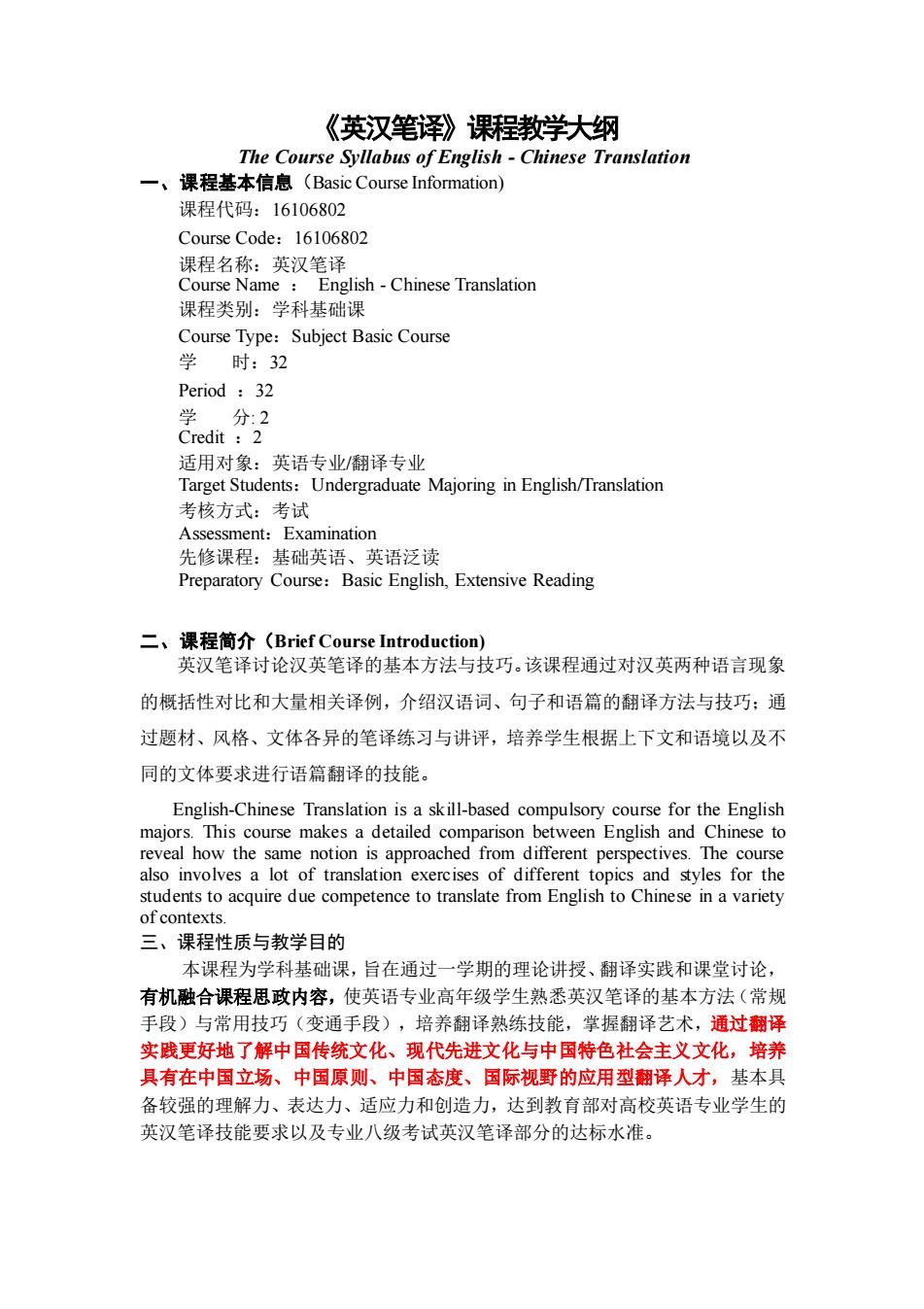
《英汉笔译》课程教学大纲 The Course Syllabus of English-Chinese Translation 一、课程基本信息(Basic Course Information) 课程代码:16106802 Course Code:16106802 课程名称:英汉笔译 English-Chinese Translation 课程类别:学科基础课 Course Type:Subiect Basic Course 时: 32 Period 32 分:2 Credit 2 适用对象 nts 考核方式:考试 Assessment:Examination 先修课程:基础英语、英语泛读 Preparatory Course:Basic English.Extensive Reading 二、课程简介(Brief Course Introduction) 英汉笔译讨论汉英笔译的基本方法与技巧。该课程通过对汉英两种语言现象 的概括性对比和大量相关译例,介绍汉语词、句子和语篇的翻译方法与技巧:通 过题材、风格、文体各异的笔译练习与讲评,培养学生根据上下文和语境以及不 同的文体要求进行语篇翻译的技能。 English-Chinese Translation is a skill-based compulsory course for the English majors.This course makes a detailed comparison between English and Chinese to reveal how the same notion is approached from different perspectives.The course also involves a lot of translation exercises different topic and styles for the dents to acquire due competence to translate from English to Chinese in a variety 三、课程性质与教学目的 本课程为学科基础课,旨在通过一学期的理论讲授、翻译实践和课堂讨论, 有机融合课程思政内容,使英语专业高年级学生熟悉英汉笔译的基本方法(常规 手段)与常用技巧(变通手段),培养翻译熟练技能,掌握翻译艺术,通过翻译 实践更好地了解中国传统文化、现代先进文化与中国特色社会主义文化,培养 具有在中国立场、中国原则、中国态度、国际视野的应用型翻译人才,基本具 备较强的理解力、表达力、适应力和创造力,达到教育部对高校英语专业学生的 英汉笔译技能要求以及专业八级考试英汉笔译部分的达标水准
《英汉笔译》课程教学大纲 The Course Syllabus of English - Chinese Translation 一、课程基本信息(Basic Course Information) 课程代码:16106802 Course Code:16106802 课程名称:英汉笔译 Course Name : English - Chinese Translation 课程类别:学科基础课 Course Type:Subject Basic Course 学 时:32 Period :32 学 分: 2 Credit :2 适用对象:英语专业/翻译专业 Target Students:Undergraduate Majoring in English/Translation 考核方式:考试 Assessment:Examination 先修课程:基础英语、英语泛读 Preparatory Course:Basic English, Extensive Reading 二、课程简介(Brief Course Introduction) 英汉笔译讨论汉英笔译的基本方法与技巧。该课程通过对汉英两种语言现象 的概括性对比和大量相关译例,介绍汉语词、句子和语篇的翻译方法与技巧;通 过题材、风格、文体各异的笔译练习与讲评,培养学生根据上下文和语境以及不 同的文体要求进行语篇翻译的技能。 English-Chinese Translation is a skill-based compulsory course for the English majors. This course makes a detailed comparison between English and Chinese to reveal how the same notion is approached from different perspectives. The course also involves a lot of translation exercises of different topics and styles for the students to acquire due competence to translate from English to Chinese in a variety of contexts. 三、课程性质与教学目的 本课程为学科基础课,旨在通过一学期的理论讲授、翻译实践和课堂讨论, 有机融合课程思政内容,使英语专业高年级学生熟悉英汉笔译的基本方法(常规 手段)与常用技巧(变通手段),培养翻译熟练技能,掌握翻译艺术,通过翻译 实践更好地了解中国传统文化、现代先进文化与中国特色社会主义文化,培养 具有在中国立场、中国原则、中国态度、国际视野的应用型翻译人才,基本具 备较强的理解力、表达力、适应力和创造力,达到教育部对高校英语专业学生的 英汉笔译技能要求以及专业八级考试英汉笔译部分的达标水准
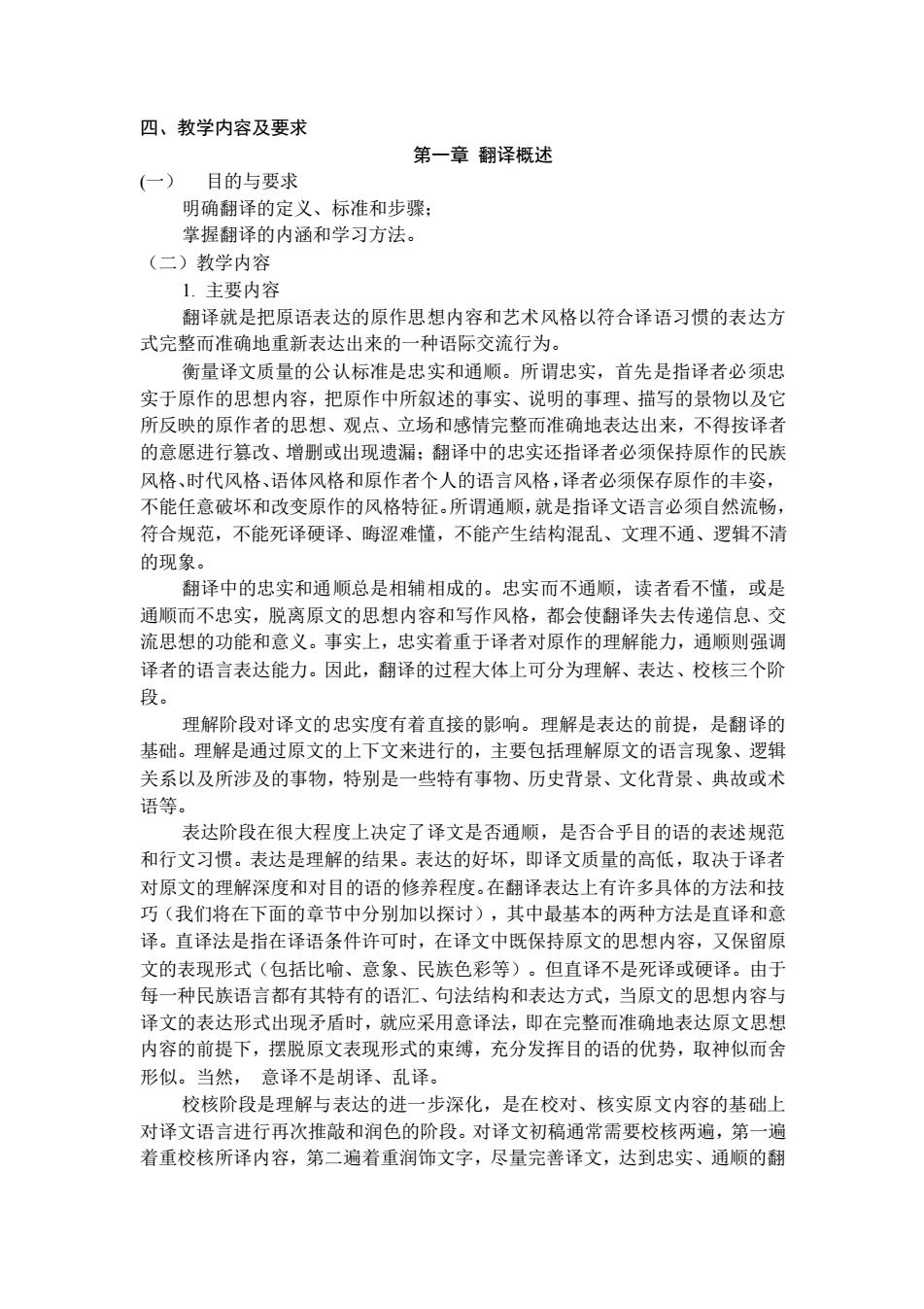
四、教学内容及要求 第一章翻译概述 (一)目的与要求 明确翻译的定义、标准和步骤: 草握翻泽的内函和学习方法 (二)教学内容 1.主要内容 翻译就是把原语表达的原作思想内容和艺术风格以符合译语习惯的表达方 式完整而准确地重新表达出来的一种语际交流行为。 衡量译文质量的公认标准是忠实和通顺。所谓忠实,首先是指译者必须忠 实于原作的思想内容,把原作中所叙述的事实、说明的事理、描写的景物以及它 所反映的原作者的思想、观点、立场和感情完整而准确地表达出来,不得按译者 的意愿进行慕改、增删或出现遗漏:翻译中的忠实还指译者必须保持原作的民族 风格、时代风格、语体风格和原作者个人的语言风格,译者必须保存原作的丰姿, 不能任意破坏和改变原作的风格特征。所谓通顺,就是指译文语言必须自然流畅 符合规范,不能死译硬译、晦涩难懂,不能产生结构混乱、文理不通、逻辑不清 的现象 翻译中的忠实和通顺总是相辅相成的。忠实而不通顺,读者看不懂,或是 肉岛茶变深独变量保的时余的去者品 译者的语言表达能力。因此,翻译的过程大体上可分为理解、表达、校核三个阶 段。 理解阶段对译文的忠实度有若直接的母影响。理解是表达的前提,是翻译的 基础。理解是通过原文的上下文来进行的,主要包括理解原文的语言现象、逻辑 关系以及所涉及的事物,特别是一些特有事物、历史背景、文化背景、典故或术 语等 表达阶段在很大程度上决定了译文是否通顶,是否合平目的语的表述规范 和行文习惯。表达是理解的结果。表达的好坏,即译文质量的高低,取决于译者 对原文的理解深度和对目的语的修养程度。在翻译表达上有许多具体的方法和技 巧(我们将在下面的音节中分别加以探对),其中最基本的两种方法是直还和意 译。直译法是指在译语条件许可时,在译文中既保持原文的思想内容,又保留原 文的表现形式(包括比喻、意象、民族色彩等)。但直译不是死译或硬译。由于 每一种民族语言都有其特有的语汇、句法结构和表达方式,当原文的思想内容与 译文的表达形式出现矛盾时,就应采用意译法,即在完整而准确地表达原文思想 内容的前提下,摆脱原文表现形式的束缚,充分发挥目的语的优势,取神似而舍 形似。当然,意译不是胡译、乱译。 校核阶段是理解与表达的进一步深化,是在校对、核实原文内容的基础上 对译文语言进行再次推敲和润色的阶段。对译文初稿通常需要校核两遍,第一遍 着重校核所译内容,第二遍着重润饰文字,尽量完善译文,达到忠实、通顺的翻
四、教学内容及要求 第一章 翻译概述 (一) 目的与要求 明确翻译的定义、标准和步骤; 掌握翻译的内涵和学习方法。 (二)教学内容 1. 主要内容 翻译就是把原语表达的原作思想内容和艺术风格以符合译语习惯的表达方 式完整而准确地重新表达出来的一种语际交流行为。 衡量译文质量的公认标准是忠实和通顺。所谓忠实,首先是指译者必须忠 实于原作的思想内容,把原作中所叙述的事实、说明的事理、描写的景物以及它 所反映的原作者的思想、观点、立场和感情完整而准确地表达出来,不得按译者 的意愿进行篡改、增删或出现遗漏;翻译中的忠实还指译者必须保持原作的民族 风格、时代风格、语体风格和原作者个人的语言风格,译者必须保存原作的丰姿, 不能任意破坏和改变原作的风格特征。所谓通顺,就是指译文语言必须自然流畅, 符合规范,不能死译硬译、晦涩难懂,不能产生结构混乱、文理不通、逻辑不清 的现象。 翻译中的忠实和通顺总是相辅相成的。忠实而不通顺,读者看不懂,或是 通顺而不忠实,脱离原文的思想内容和写作风格,都会使翻译失去传递信息、交 流思想的功能和意义。事实上,忠实着重于译者对原作的理解能力,通顺则强调 译者的语言表达能力。因此,翻译的过程大体上可分为理解、表达、校核三个阶 段。 理解阶段对译文的忠实度有着直接的影响。理解是表达的前提,是翻译的 基础。理解是通过原文的上下文来进行的,主要包括理解原文的语言现象、逻辑 关系以及所涉及的事物,特别是一些特有事物、历史背景、文化背景、典故或术 语等。 表达阶段在很大程度上决定了译文是否通顺,是否合乎目的语的表述规范 和行文习惯。表达是理解的结果。表达的好坏,即译文质量的高低,取决于译者 对原文的理解深度和对目的语的修养程度。在翻译表达上有许多具体的方法和技 巧(我们将在下面的章节中分别加以探讨),其中最基本的两种方法是直译和意 译。直译法是指在译语条件许可时,在译文中既保持原文的思想内容,又保留原 文的表现形式(包括比喻、意象、民族色彩等)。但直译不是死译或硬译。由于 每一种民族语言都有其特有的语汇、句法结构和表达方式,当原文的思想内容与 译文的表达形式出现矛盾时,就应采用意译法,即在完整而准确地表达原文思想 内容的前提下,摆脱原文表现形式的束缚,充分发挥目的语的优势,取神似而舍 形似。当然, 意译不是胡译、乱译。 校核阶段是理解与表达的进一步深化,是在校对、核实原文内容的基础上 对译文语言进行再次推敲和润色的阶段。对译文初稿通常需要校核两遍,第一遍 着重校核所译内容,第二遍着重润饰文字,尽量完善译文,达到忠实、通顺的翻
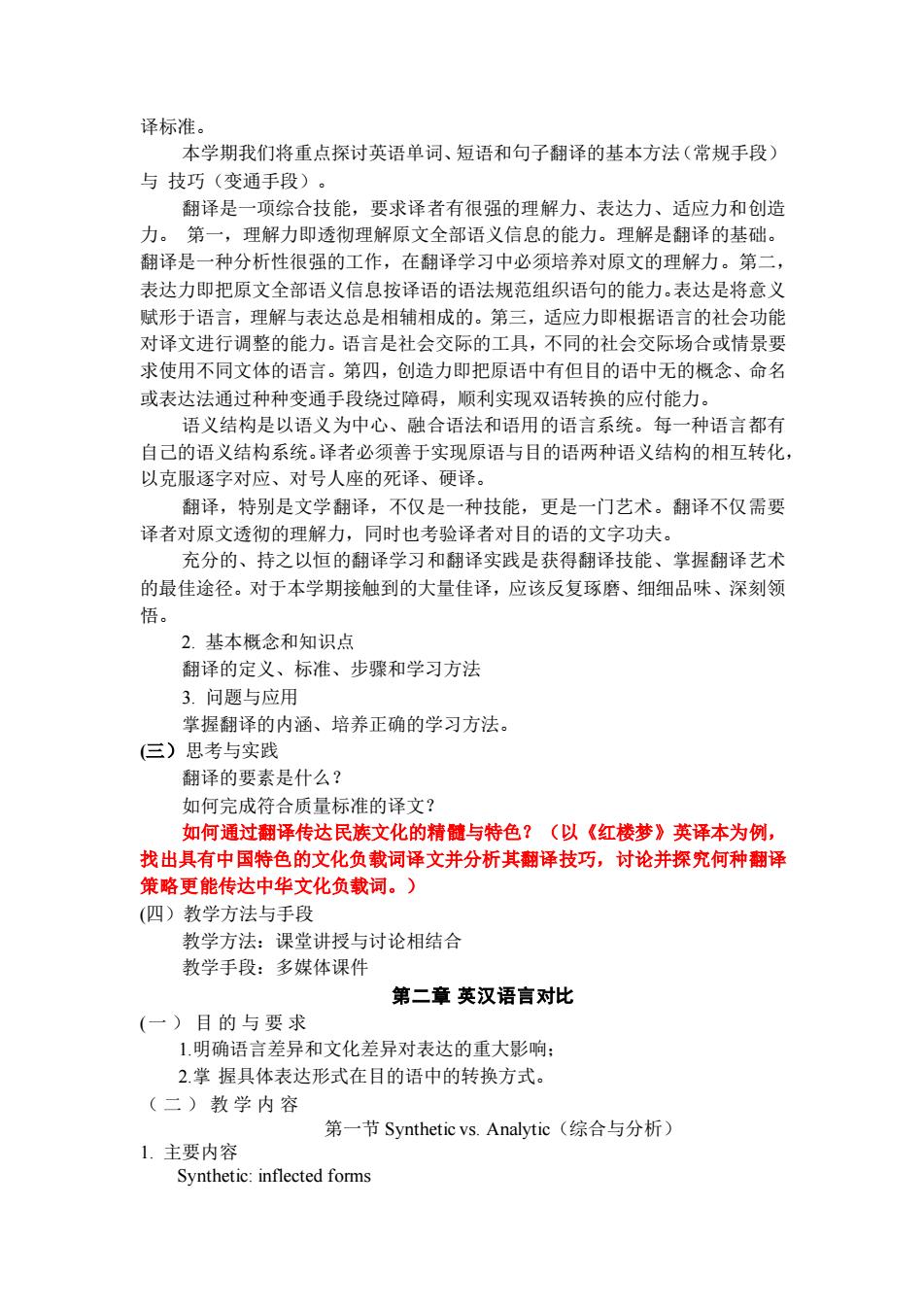
译标准。 本学期我们将重点探讨英语单词、短语和句子翻译的基本方法(常规手段) 与技巧(变通手段)。 翻译是一项综合技能,要求译者有很强的理解力、表达力、适应力和创造 力。第一,理解力即透彻理解原文全部语义信息的能力。理解是翻译的基础。 翻译是一种分析性很强的工作,在翻译学习中必须培养对原文的理解力。第二, 表达力即把原文全部语义信息按译语的语法规范组织语句的能力。表达是将意义 赋形于语言,理解与表达总是相辅相成的。第三,适应力即根据语言的社会功能 对译文进行调整的能力。语言是社会交际的工具,不同的社会交际场合或情景要 求使用不同文体的语言。第四,创造力即把原语中有但目的语中无的概念、命名 或表达法通过种种变通手段绕过障碍,顺利实现双语转换的应付能力。 语义结构是以语义为中心、融合语法和语用的语言系统。每一种语言都有 自己的语义结构系统。译者必须善于实现原语与目的语两种语义结构的相互转化, 以克服逐字对应、对号人座的死译、硬译。 翻译,特别是文学翻译,不仅是一种技能,更是一门艺术。翻译不仅需要 译者对原文透彻的理解力,同时也考验译者对目的语的文字功夫。 充分的、持之以恒的翻译学习和翻译实践是获得翻译技能、掌握翻译艺术 的最佳途径。对于本学期接触到的大量佳译,应该反复琢磨、细细品味、深刻领 悟 2.基本概念和知识点 翻译的定义、标准、步骤和学习方法 3.问题与应用 掌握翻译的内涵、培养正确的学习方法。 (三)思考与实践 翻译的要素是什么? 如何完成符合质量标准的译文? 如何通过翻译传达民族文化的精髓与特色?(以《红楼梦》英译本为例, 找出具有中国特色的文化负载词译文并分析其翻译技巧,讨论并探究何种翻译 策略更能传达中华文化负载词。) (四)教学方法与手段 教学方法:课堂讲授与讨论相结合 教学手段:多媒体课件 第二章英汉语言对比 (一)目的与要求 1明确语言差异和文化差异对表达的重大影响 2.掌握具体表达形式在目的语中的转换方式。 (二)教学内容 第一节Synthetic vs..Analytic(综合与分析 1.主要内容 Synthetic:inflected forms
译标准。 本学期我们将重点探讨英语单词、短语和句子翻译的基本方法(常规手段) 与 技巧(变通手段)。 翻译是一项综合技能,要求译者有很强的理解力、表达力、适应力和创造 力。 第一,理解力即透彻理解原文全部语义信息的能力。理解是翻译的基础。 翻译是一种分析性很强的工作,在翻译学习中必须培养对原文的理解力。第二, 表达力即把原文全部语义信息按译语的语法规范组织语句的能力。表达是将意义 赋形于语言,理解与表达总是相辅相成的。第三,适应力即根据语言的社会功能 对译文进行调整的能力。语言是社会交际的工具,不同的社会交际场合或情景要 求使用不同文体的语言。第四,创造力即把原语中有但目的语中无的概念、命名 或表达法通过种种变通手段绕过障碍,顺利实现双语转换的应付能力。 语义结构是以语义为中心、融合语法和语用的语言系统。每一种语言都有 自己的语义结构系统。译者必须善于实现原语与目的语两种语义结构的相互转化, 以克服逐字对应、对号人座的死译、硬译。 翻译,特别是文学翻译,不仅是一种技能,更是一门艺术。翻译不仅需要 译者对原文透彻的理解力,同时也考验译者对目的语的文字功夫。 充分的、持之以恒的翻译学习和翻译实践是获得翻译技能、掌握翻译艺术 的最佳途径。对于本学期接触到的大量佳译,应该反复琢磨、细细品味、深刻领 悟。 2. 基本概念和知识点 翻译的定义、标准、步骤和学习方法 3. 问题与应用 掌握翻译的内涵、培养正确的学习方法。 (三)思考与实践 翻译的要素是什么? 如何完成符合质量标准的译文? 如何通过翻译传达民族文化的精髓与特色?(以《红楼梦》英译本为例, 找出具有中国特色的文化负载词译文并分析其翻译技巧,讨论并探究何种翻译 策略更能传达中华文化负载词。) (四)教学方法与手段 教学方法:课堂讲授与讨论相结合 教学手段:多媒体课件 第二章 英汉语言对比 (一)目的与要求 1.明确语言差异和文化差异对表达的重大影响; 2.掌 握具体表达形式在目的语中的转换方式。 ( 二 ) 教学内容 第一节 Synthetic vs. Analytic(综合与分析) 1. 主要内容 Synthetic: inflected forms
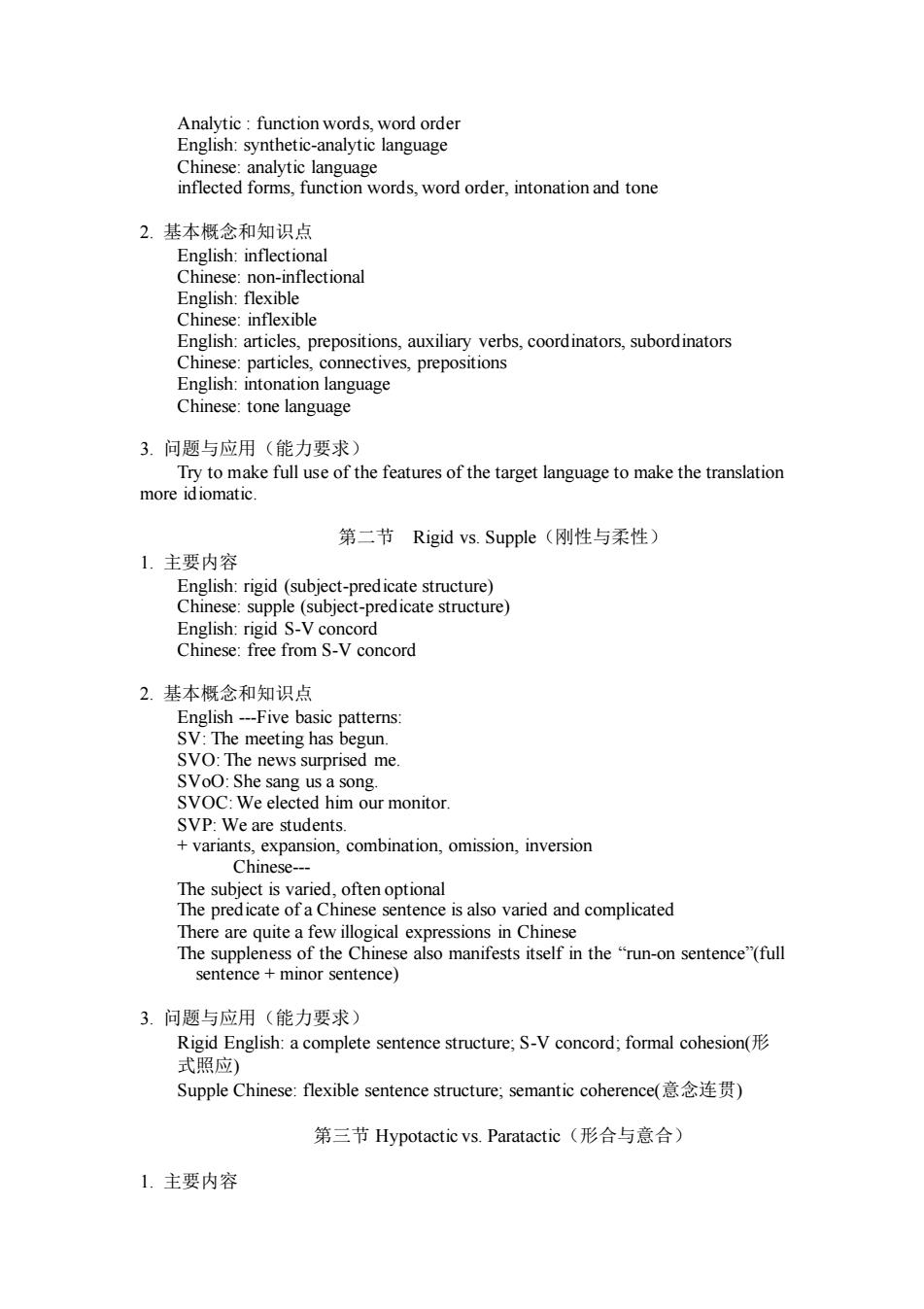
Analytic:function words,word order English:synthetic-analytic language Chinese:analytic language inflected forms.function words.word order.intonation and tone 2.基本概念和知识点 English:inflectional Chinese:non-inflectional English:flexible Chinese:inflexible Ch articles,prepositions,auxiliary verbs,coordinators,subordinators se:partic connectives,prepositions intonation language 3.问题与应用(能力要求》 ry to ma e full use of the features of the target language to make the translation more idiomati 第二节Rigid vs..Supple(刚性与柔性》 1.主要内容 se:supple ject-predicate structure V concord 2.基本概念和知识点 Five bas eeting has :Sha SVOC.We ele ted him our monitor SVP.We are students +variants.expansion,combination,omission,inversion Chinese- The subject is varied,oftenoptional The predicate ofa Chinese sentence is also varied and complicated There are quite a few illogical expressions in Chinese The suppleness of the Chinese also manifests itself in the "run-on sentence"(full sentence minor sentence) 3.问题与应用(能力要求 Rigid English:a complete sentence structure;S-V concord:formal cohesion( 式照应) Supple Chinese:flexible sentence structure,semantic coherence(意念连贯) 第三节Hypotactic vs.Paratactic(形合与意合) 1.主要内容
Analytic : function words, word order English: synthetic-analytic language Chinese: analytic language inflected forms, function words, word order, intonation and tone 2. 基本概念和知识点 English: inflectional Chinese: non-inflectional English: flexible Chinese: inflexible English: articles, prepositions, auxiliary verbs, coordinators, subordinators Chinese: particles, connectives, prepositions English: intonation language Chinese: tone language 3. 问题与应用(能力要求) Try to make full use of the features of the target language to make the translation more idiomatic. 第二节 Rigid vs. Supple(刚性与柔性) 1. 主要内容 English: rigid (subject-predicate structure) Chinese: supple (subject-predicate structure) English: rigid S-V concord Chinese: free from S-V concord 2. 基本概念和知识点 English ---Five basic patterns: SV: The meeting has begun. SVO: The news surprised me. SVoO: She sang us a song. SVOC: We elected him our monitor. SVP: We are students. + variants, expansion, combination, omission, inversion Chinese--- The subject is varied, often optional The predicate of a Chinese sentence is also varied and complicated There are quite a few illogical expressions in Chinese The suppleness of the Chinese also manifests itself in the “run-on sentence”(full sentence + minor sentence) 3. 问题与应用(能力要求) Rigid English: a complete sentence structure; S-V concord; formal cohesion(形 式照应) Supple Chinese: flexible sentence structure; semantic coherence(意念连贯) 第三节 Hypotactic vs. Paratactic(形合与意合) 1. 主要内容
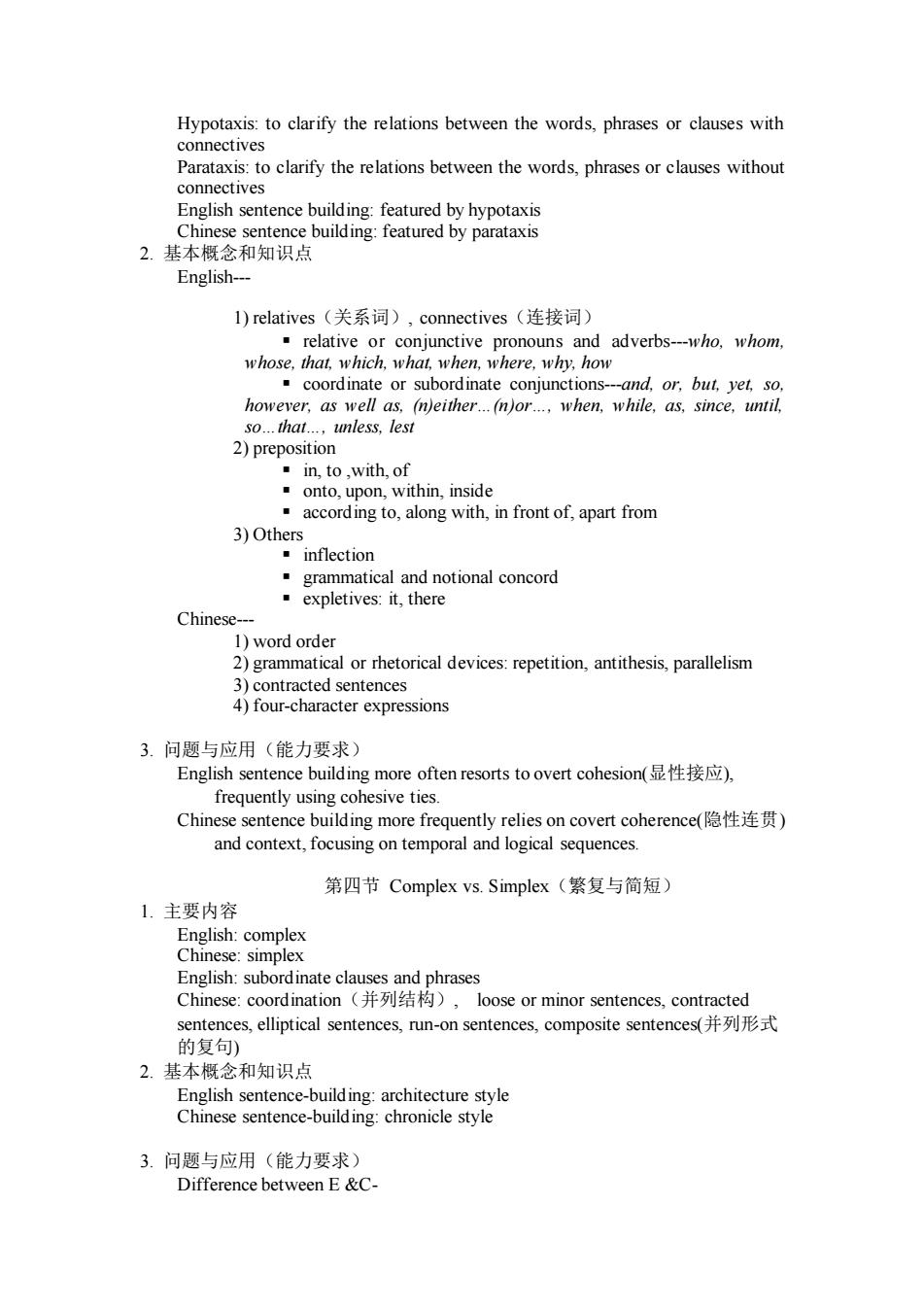
Hypotaxis:to clarify the relations between the words,phrases or clauses with connectives Parataxis:to clarify the relations between the words,phrases or clauses without connectives English sentence building:featured by hypotaxis Chinese se entenc building:featured by parataxis 2.基本概念和知识点 English-- l)relatives(关系词),connectives(连接词) ve pronouns here,wh rdin or su eithe conjunct nd,or. howe so that 2)preposition ■into.with of "onto,upon,within,inside "according to,along with,in front of,apart from 3)Others inflection grammatical and notional concord expletives:it.there Chinese 1)word orde d r expressions 3.问题与应用(能力要求) sentence building more often resorts toovert cohesion(显性接应), frequently using cohesive ties. Chinese sentence building more frequently relies on covert coherence(隐性连贯) and context,focusing on temporal and logical sequences. 第四节Complex vs.Simplex(繁复与简短 1.主要内容 English:complex Chinese:simplex English:subordinate clauses and phrases Chinese:coordination(并列结构),loose or minor sentences.contracted sentences,elliptical sentences,run-on sentences,.composite sentences(并列形式 的复句) 2.基本概念和知识点 3.问题与应用(能力要求) Difference between E&C
Hypotaxis: to clarify the relations between the words, phrases or clauses with connectives Parataxis: to clarify the relations between the words, phrases or clauses without connectives English sentence building: featured by hypotaxis Chinese sentence building: featured by parataxis 2. 基本概念和知识点 English--- 1) relatives(关系词), connectives(连接词) ▪ relative or conjunctive pronouns and adverbs---who, whom, whose, that, which, what, when, where, why, how ▪ coordinate or subordinate conjunctions---and, or, but, yet, so, however, as well as, (n)either…(n)or…, when, while, as, since, until, so…that…, unless, lest 2) preposition ▪ in, to ,with, of ▪ onto, upon, within, inside ▪ according to, along with, in front of, apart from 3) Others ▪ inflection ▪ grammatical and notional concord ▪ expletives: it, there Chinese--- 1) word order 2) grammatical or rhetorical devices: repetition, antithesis, parallelism 3) contracted sentences 4) four-character expressions 3. 问题与应用(能力要求) English sentence building more often resorts to overt cohesion(显性接应), frequently using cohesive ties. Chinese sentence building more frequently relies on covert coherence(隐性连贯) and context, focusing on temporal and logical sequences. 第四节 Complex vs. Simplex(繁复与简短) 1. 主要内容 English: complex Chinese: simplex English: subordinate clauses and phrases Chinese: coordination(并列结构), loose or minor sentences, contracted sentences, elliptical sentences, run-on sentences, composite sentences(并列形式 的复句) 2. 基本概念和知识点 English sentence-building: architecture style Chinese sentence-building: chronicle style 3. 问题与应用(能力要求) Difference between E &C-
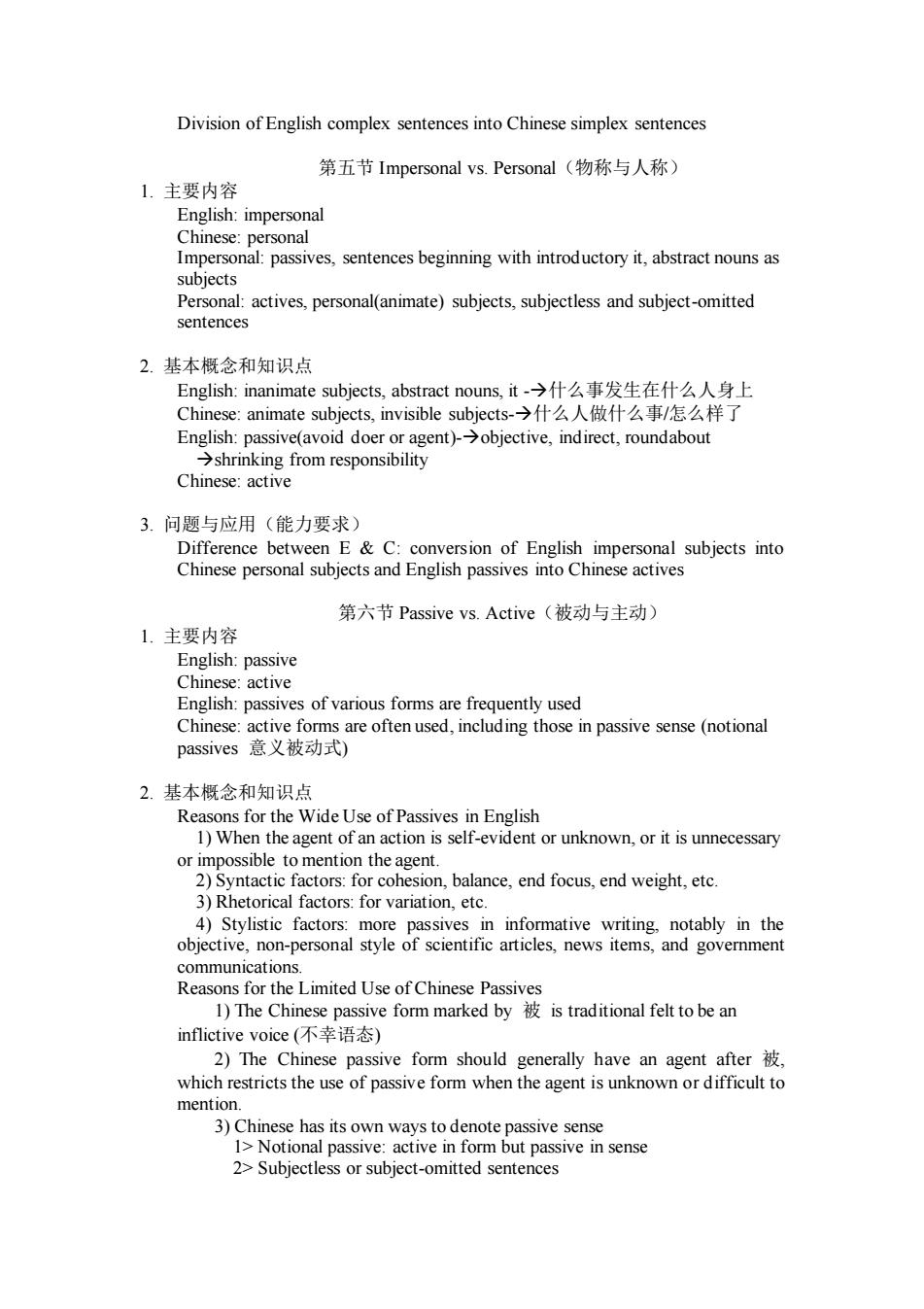
Division of English complex sentences into Chinese simplex sentences 第五节Impersonal vs..Personal(物称与人称) 1.主要内容 English:impersonal Chinese: rsonal:pas sives.sentences beginning with introductory it abstract nouns as subiects Personal:actives,personal(animate)subjects,subjectless and subject-omitted sentences 2.基本概念和知识点 English:inanimate subjects,.abstract nouns,it-→什么事发生在什么人身上 Chinese:animate subje cts,invisible subjects--→什么人做什么事/怎么样了 English pas oid doe gent)→objective,. roundabout Chinese:active from responsibility 3.问题与应用(能力要求) Difference betw E&C rsion of English in onal subjects into Chinese personal subiects and English passives toChin se actives 第六节Passive vs..Active(被动与主动) 1.主要内容 :passi English ently used Chinese: ctive fo are often used,including those in passive sense (notional passives意义被动式) 2.基本概念和知识点 the Wide Use of Pa e age t of or synt ors:the 3Rhetorical factors:for variation on,balance,end focus,end weight,etc. etc 4)Stylistic factors:more passives in informative writing.notably in the objective,non-personal style of scientific articles,news items,and government communications Reasons for the Limited Use of Chinese Passives 1)The Chinese passive form marked by is traditional felt to be an inflictive voice(不幸语态) sive form should generally have an agent after ets the o pave om when theor t 3)Chir n w ys to d I>Not onal in fo 2>Subiectless or subjec -omitted sentences
Division of English complex sentences into Chinese simplex sentences 第五节 Impersonal vs. Personal(物称与人称) 1. 主要内容 English: impersonal Chinese: personal Impersonal: passives, sentences beginning with introductory it, abstract nouns as subjects Personal: actives, personal(animate) subjects, subjectless and subject-omitted sentences 2. 基本概念和知识点 English: inanimate subjects, abstract nouns, it -→什么事发生在什么人身上 Chinese: animate subjects, invisible subjects-→什么人做什么事/怎么样了 English: passive(avoid doer or agent)-→objective, indirect, roundabout →shrinking from responsibility Chinese: active 3. 问题与应用(能力要求) Difference between E & C: conversion of English impersonal subjects into Chinese personal subjects and English passives into Chinese actives 第六节 Passive vs. Active(被动与主动) 1. 主要内容 English: passive Chinese: active English: passives of various forms are frequently used Chinese: active forms are often used, including those in passive sense (notional passives 意义被动式) 2. 基本概念和知识点 Reasons for the Wide Use of Passives in English 1) When the agent of an action is self-evident or unknown, or it is unnecessary or impossible to mention the agent. 2) Syntactic factors: for cohesion, balance, end focus, end weight, etc. 3) Rhetorical factors: for variation, etc. 4) Stylistic factors: more passives in informative writing, notably in the objective, non-personal style of scientific articles, news items, and government communications. Reasons for the Limited Use of Chinese Passives 1) The Chinese passive form marked by 被 is traditional felt to be an inflictive voice (不幸语态) 2) The Chinese passive form should generally have an agent after 被, which restricts the use of passive form when the agent is unknown or difficult to mention. 3) Chinese has its own ways to denote passive sense 1> Notional passive: active in form but passive in sense 2> Subjectless or subject-omitted sentences

3>Using generic person as subjects 4>Using executive form(处置式) 3.问题与应用(能力要求) Transference from the English passive to Chinese active 第七节Static ys.Dynamic(静态与动态】 1.主要内容 ·English:fe ed by its predominance of nouns over verbs. nouns:ref vebs:ndicaecin activity,temporary or changing conditions 2.基本概念和知识点 English static Tendency 1>using agentive noun instead of verbs .2>using headline phrase instead ofadjectives 3>predominance of nouns leading to wide use of prepositions 4>feeblization of verbs 5>using adjectives or adverbs instead of verbs .Chinese Dynamic Tendency ·1>动词连用 ·2>动词(词组)充当汉语句子的各种成分 ·3>汉语动词常常重复或重叠 3.问颗与应用(能力要求】 ■Owin to the difference a e,th conversion of the English the CH ctives into prep ositions into verbs. nouns into tc 第八节Abstract vs..Concrete(抽象与具体) 1.主要内容 ·English:abstrac nalization often results in abstraction.An exc at th se of the v will.in the end.detach the ter from ealiti of he and the from when and how and in what mood the thing was done.and insensibly induce a habit of abstraction,generalization and vagueness "Chinese:prefers to use concrete or specific words and employs a"down-to-earth"style,often making abstract ideas plain by metaphors, similes,allegories,or other devices. 2.基本概念和知识点 "English Abstract Tendency 1>regarding abstract thinking a superior mind,a mark of civilized man
3>Using generic person as subjects 4>Using executive form (处置式) 3. 问题与应用(能力要求) Transference from the English passive to Chinese active 第七节 Static vs. Dynamic(静态与动态) 1. 主要内容 ▪ English: static ▪ Chinese: dynamic ▪ English: featured by its predominance of nouns over verbs; nouns: refer to entities that are stable ▪ Chinese: more verbs used than nouns; verbs: indicate action, activity, temporary or changing conditions 2. 基本概念和知识点 ▪English Static Tendency ▪ 1> using agentive noun instead of verbs ▪ 2> using headline phrase instead of adjectives ▪ 3> predominance of nouns leading to wide use of prepositions ▪ 4> feeblization of verbs ▪ 5> using adjectives or adverbs instead of verbs ▪Chinese Dynamic Tendency ▪ 1> 动词连用 ▪ 2> 动词(词组)充当汉语句子的各种成分 ▪ 3> 汉语动词常常重复或重叠 3. 问题与应用(能力要求) ▪ Owing to the difference above, the conversion of the English nominal style into the Chinese verbal style is necessary: nouns into verbs, adjectives into adverbs, prepositions into verbs, etc. 第八节 Abstract vs. Concrete(抽象与具体) 1. 主要内容 ▪ English: abstract ▪ Chinese: concrete ▪ English: Nominalization often results in abstraction. An excessive reliance on the noun at the expense of the verb will, in the end, detach the mind of the writer from the realities of here and there, from when and how and in what mood the thing was done, and insensibly induce a habit of abstraction, generalization and vagueness. ▪ Chinese: prefers to use concrete or specific words and employs a “down-to-earth” style, often making abstract ideas plain by metaphors, similes, allegories, or other devices. 2. 基本概念和知识点 ▪English Abstract Tendency ▪ 1> regarding abstract thinking a superior mind, a mark of civilized man
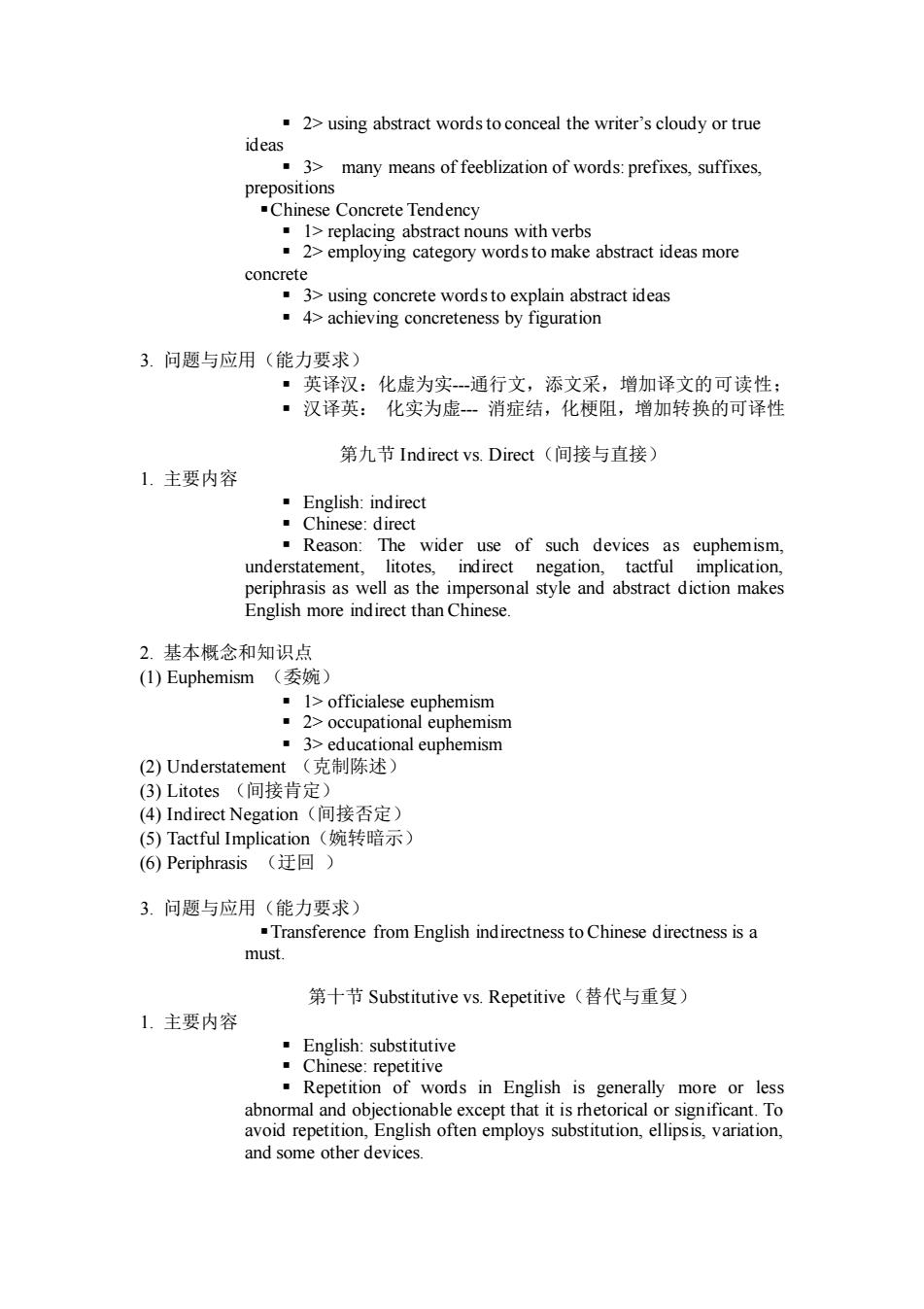
"2>using abstract words to conceal the writer's cloudy or true ideas 3>many means of feeblization of words:prefixes,suffixes, prepositions .Chinese Concrete Tendency 25pc盟ecaremgoNodbetetsaliesae concrete using concrete words to explain abstract ideas 4>achieving concreteness by figuration 3.问题与应用(能力要求) ·英译汉:化虚为实通行文,添文采,增加译文的可读性 ·汉译英:化实为虚一消症结,化梗阻,增加转换的可译性 第九节Indirect vs.Direct(间接与直接) 1.主要内容 ■English:indirect ■Chinese'direct Reason:The wider use of such devices as euphemism understatement,litotes,indirect negation,tactful implication, periphrasis as well as the impersonal style and abstract diction makes English more indirect than Chinese. 2.基本概念和知识点 (I)Euphemism(委婉) 1>officialese euphemism 2>occupational euphemism 3>educational euphemism (2)Understatement(克制陈述) (3)Litotes(间接肯定) (4)Indi ct negation(间接否定) (5)Tactful Implica 婉转暗示 (6)Periphrasis(过回) 3.问题与应用(能力要求) .Transference from English indirectness to Chinese directness is a must. 第十节Substitutive vs.Repetitive(替代与重复) 1.主要内容 "English:substitutive ·Chinese:repetitive .Repetition of words in English is generally more or less abnormal and objectionable except that it is rhetorical or significant.To avoid repetition,English often employs substitution,ellipsis,variation, and some other devices
▪ 2> using abstract words to conceal the writer’s cloudy or true ideas ▪ 3> many means of feeblization of words: prefixes, suffixes, prepositions ▪Chinese Concrete Tendency ▪ 1> replacing abstract nouns with verbs ▪ 2> employing category words to make abstract ideas more concrete ▪ 3> using concrete words to explain abstract ideas ▪ 4> achieving concreteness by figuration 3. 问题与应用(能力要求) ▪ 英译汉:化虚为实---通行文,添文采,增加译文的可读性; ▪ 汉译英: 化实为虚--- 消症结,化梗阻,增加转换的可译性 第九节 Indirect vs. Direct(间接与直接) 1. 主要内容 ▪ English: indirect ▪ Chinese: direct ▪ Reason: The wider use of such devices as euphemism, understatement, litotes, indirect negation, tactful implication, periphrasis as well as the impersonal style and abstract diction makes English more indirect than Chinese. 2. 基本概念和知识点 (1) Euphemism (委婉) ▪ 1> officialese euphemism ▪ 2> occupational euphemism ▪ 3> educational euphemism (2) Understatement (克制陈述) (3) Litotes (间接肯定) (4) Indirect Negation(间接否定) (5) Tactful Implication(婉转暗示) (6) Periphrasis (迂回 ) 3. 问题与应用(能力要求) ▪Transference from English indirectness to Chinese directness is a must. 第十节 Substitutive vs. Repetitive(替代与重复) 1. 主要内容 ▪ English: substitutive ▪ Chinese: repetitive ▪ Repetition of words in English is generally more or less abnormal and objectionable except that it is rhetorical or significant. To avoid repetition, English often employs substitution, ellipsis, variation, and some other devices
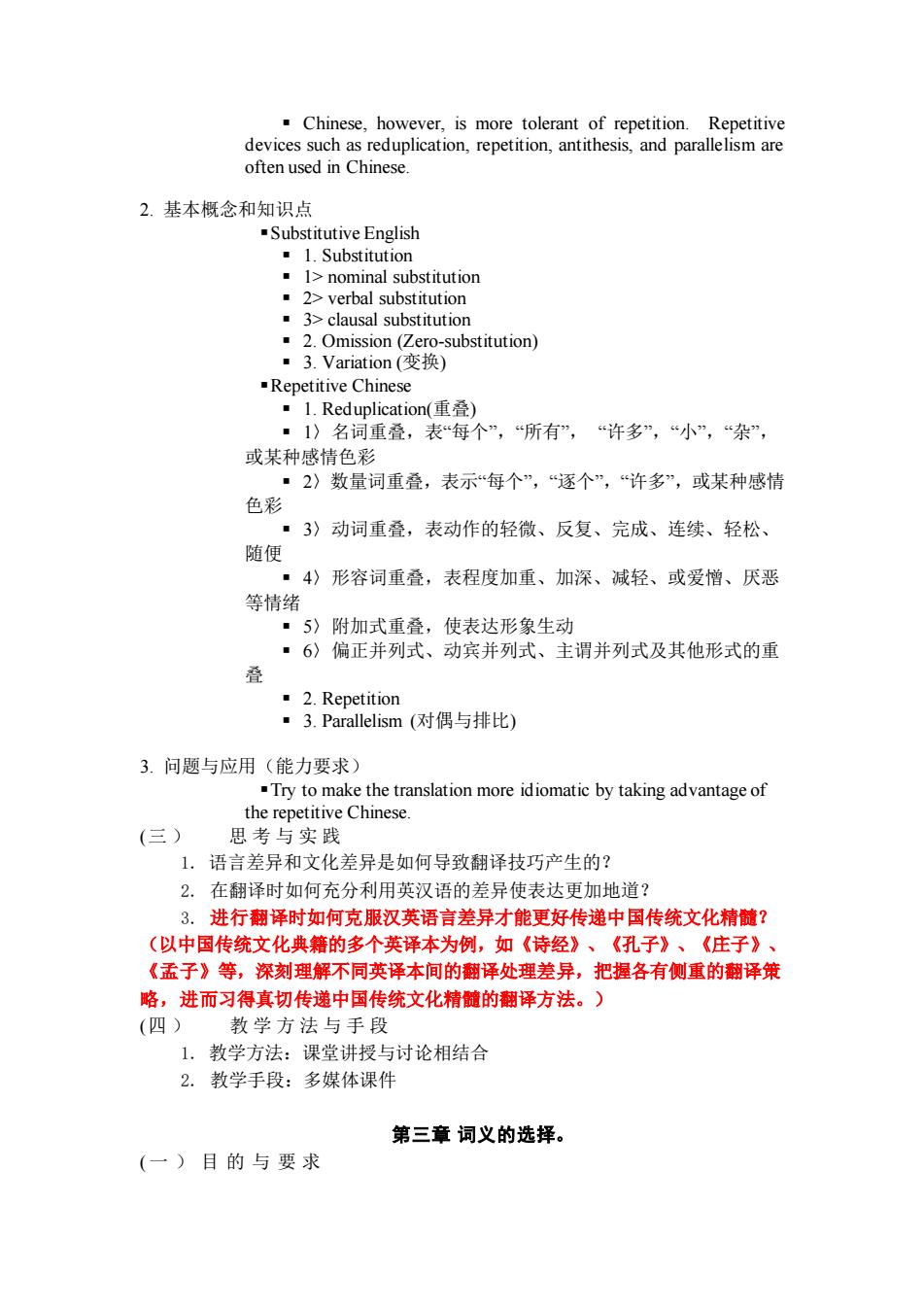
.Chinese,however,is more tolerant of repetition.Repetitive devices such as reduplication,repetition,antithesis,and parallelism are often used in Chinese. 2.基本概念和知识点 Substitutive English ·l.Substitution 1>nominal substitution verbal substitution .2 clausal substitution ubstitution) Repetitive Chinese ·1.Reduplication(重叠) 。1》名词重叠,表“每个”,“所有”,“许多”,“小”,“杂”, 或某种感情色彩 ■2》数量词重叠,表示“每个”,“逐个”,“许名”,或某种感情 色彩 ·3》动词重叠,表动作的轻微、反复、完成、连续、轻松 随 ·4)形容词重叠,表程度加重、加深、减轻、或爱憎、厌恶 等情绪 ■5)附加式重叠,使表达形象生动 ·6)偏正并列式、动宾并列式、主谓并列式及其他形式的重 叠 ·2.Repetition ·3.Parallelism(对偶与排比) 3.问题与应用(能力要求) Try to make the translation more idiomatic by taking advantage of the repetitive Chinese. (三) 思考与实践 1.语言差异和文化差异是如何导致翻译技巧产生的 2.在翻译时如何充分利用英汉语的差异使表达更加地道? 3.进行翻译时如何克服汉英语言差异才能更好传递中国传统文化精髓? (以中国传统文化典籍的多个英译本为例,如《诗经》、《孔子》、《庄子》、 《孟子》等,深刻理解不同英译本间的翻译处理差异,把握各有侧重的翻译策 略,进而习得真切传递中国传统文化精髓的翻译方法。) (四) 数学方法与毛段 1.教学方法:课堂讲授与讨论相结合 2.教学手段:多媒体课件 第三章词义的选择。 (一)目的与要求
▪ Chinese, however, is more tolerant of repetition. Repetitive devices such as reduplication, repetition, antithesis, and parallelism are often used in Chinese. 2. 基本概念和知识点 ▪Substitutive English ▪ 1. Substitution ▪ 1> nominal substitution ▪ 2> verbal substitution ▪ 3> clausal substitution ▪ 2. Omission (Zero-substitution) ▪ 3. Variation (变换) ▪Repetitive Chinese ▪ 1. Reduplication(重叠) ▪ 1〉名词重叠,表“每个”,“所有”, “许多”,“小”,“杂”, 或某种感情色彩 ▪ 2〉数量词重叠,表示“每个”,“逐个”,“许多”,或某种感情 色彩 ▪ 3〉动词重叠,表动作的轻微、反复、完成、连续、轻松、 随便 ▪ 4〉形容词重叠,表程度加重、加深、减轻、或爱憎、厌恶 等情绪 ▪ 5〉附加式重叠,使表达形象生动 ▪ 6〉偏正并列式、动宾并列式、主谓并列式及其他形式的重 叠 ▪ 2. Repetition ▪ 3. Parallelism (对偶与排比) 3. 问题与应用(能力要求) ▪Try to make the translation more idiomatic by taking advantage of the repetitive Chinese. (三 ) 思考与实践 1. 语言差异和文化差异是如何导致翻译技巧产生的? 2. 在翻译时如何充分利用英汉语的差异使表达更加地道? 3. 进行翻译时如何克服汉英语言差异才能更好传递中国传统文化精髓? (以中国传统文化典籍的多个英译本为例,如《诗经》、《孔子》、《庄子》、 《孟子》等,深刻理解不同英译本间的翻译处理差异,把握各有侧重的翻译策 略,进而习得真切传递中国传统文化精髓的翻译方法。) (四 ) 教学方法与手段 1. 教学方法:课堂讲授与讨论相结合 2. 教学手段:多媒体课件 第三章 词义的选择。 ( 一 ) 目 的 与 要 求

1.掌握英汉语汇在不同的语境中含义差别: 2培养依靠上下文来决定词语各种含义的判断力。 (二)教学内容 第一节Choice of Affective Meanings(情感意义) 1.主要内容 ·Neutral中性 ,Derogatory贬义 2.基本概念和知识点 The same word can have different affective meanings in different context. 3.问题与应用(能力要求) Choose the right affective meaning. 第二节Choice of Grammatical Meanings(语法意义) 1.主要内容 2.c n se the me or Differ art ofs 3.问题与应用能力要求 Choose the right grammatical meaning 第三节Choice of Contextual Meanings(语境意义) 1.主要内容 2米之霜器derd bythe cone context,logic 3.问题与应用(能力要求) Choose the right contextual meaning 第四节.Choice of Collocative Meanings(搭配意义) 1.主要内容 2老环减经和贺ln Every lang collocation,cognition 3.问题与应用 (能力要求) Choose the right collocative meaning 第五节.Choice of Stylistic Meanings(文体意义) 1.主要内容 Some words convey the same idea but differ in stylistic features.These words are known as ny erent stylistic features are clearly marked as formal 2基和 arcnaic,slang.et ome Chinese stylis
1.掌握英汉语汇在不同的语境中含义差别; 2.培养依靠上下文来决定词语各种含义的判断力。 ( 二)教学内容 第一节 Choice of Affective Meanings(情感意义 ) 1. 主要内容 ▪ Three types of affective meanings: ▪ Positive 褒义 ▪ Neutral 中性 ▪ Derogatory 贬义 2. 基本概念和知识点 The same word can have different affective meanings in different context. 3. 问题与应用(能力要求) Choose the right affective meaning. 第二节 Choice of Grammatical Meanings(语法意义) 1. 主要内容 Different part of speech can give the same word different meanings. 2. 基本概念和知识点 part of speech, meaning 3. 问题与应用(能力要求) Choose the right grammatical meaning 第三节 Choice of Contextual Meanings(语境意义) 1. 主要内容 The meaning of a word is defined by the context 2. 基本概念和知识点 context, logic 3. 问题与应用(能力要求) Choose the right contextual meaning 第四节. Choice of Collocative Meanings(搭配意义) 1. 主要内容 Every language has its own usage and collocations. 2. 基本概念和知识点 collocation, cognition 3. 问题与应用(能力要求) Choose the right collocative meaning 第五节. Choice of Stylistic Meanings(文体意义) 1. 主要内容 Some words convey the same idea but differ in stylistic features. These words are known as stylistic synonyms. In some dictionaries, the different stylistic features are clearly marked as formal, informal, literary, archaic, slang, etc. 2. 基本概念和知识点 ▪ Some Chinese stylistic synonyms ▪ Oral vs. written(口语/书面语)